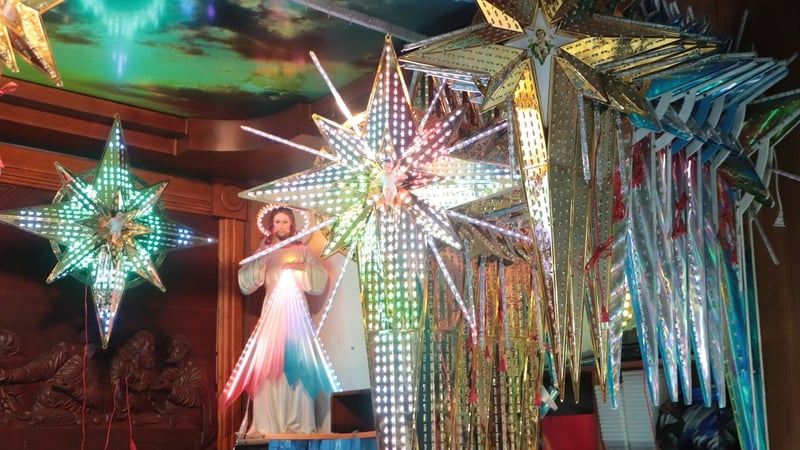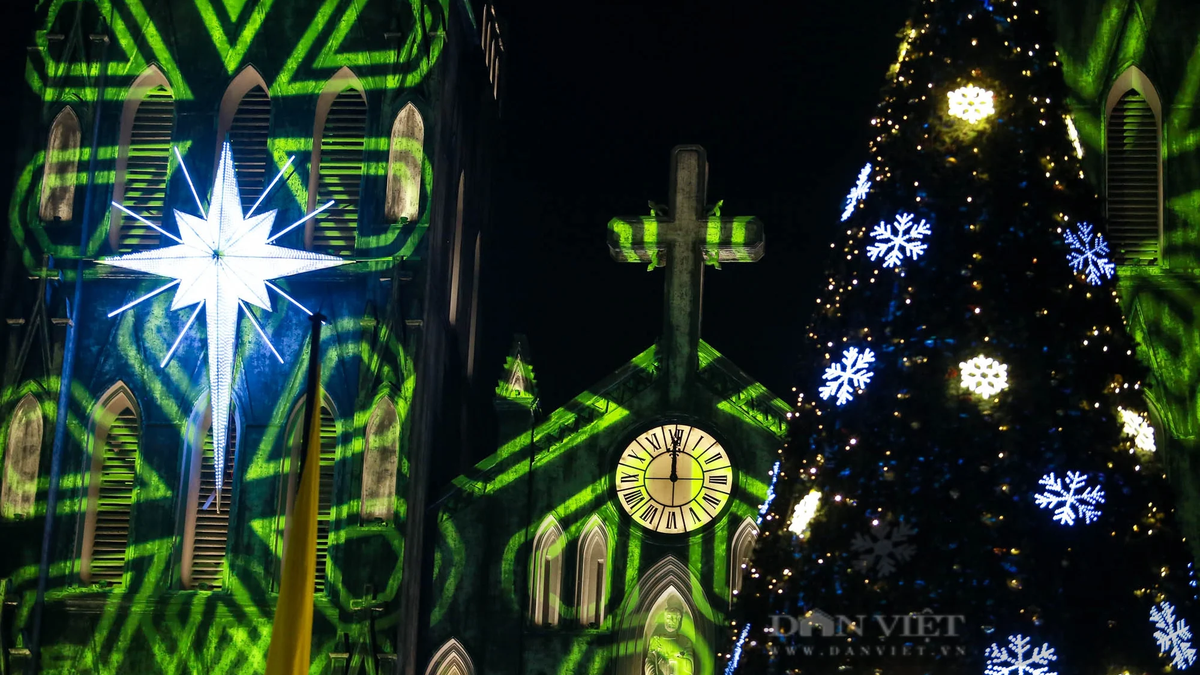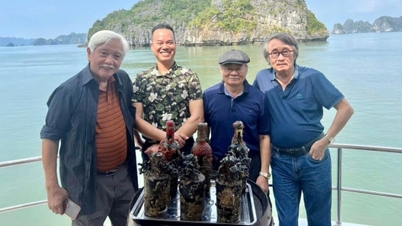![[Photo] Visiting the](https://vstatic.vietnam.vn/vietnam/resource/IMAGE/2025/1/21/7521ffcebfe04c3099e144d3239de407) Despite launching at the end of 2023, the "Wooden Fish Village - Behind the Glory" tour has not diminished in popularity. Visiting Quynh Doi village, tourists not only have the opportunity to visit this renowned scholarly land of Nghe An province but also to hear the legend of the wooden fish, and to understand the story of the founders, the hardships of bringing teachers to the village to maintain the tradition of learning.
Despite launching at the end of 2023, the "Wooden Fish Village - Behind the Glory" tour has not diminished in popularity. Visiting Quynh Doi village, tourists not only have the opportunity to visit this renowned scholarly land of Nghe An province but also to hear the legend of the wooden fish, and to understand the story of the founders, the hardships of bringing teachers to the village to maintain the tradition of learning. ![[Photo] Visiting the](https://image.nhandan.vn/w2000/Uploaded/2024/wbgagznrxggzhvdatga/2024_01_24/z5076523571203-ef4abede457a46d17ee33630819b8fc7-4330.jpg.webp) |
| Quynh Doi village, located in Quynh Doi commune, Quynh Luu district, Nghe An province, is renowned as a long-standing cultural "cradle" with a tradition of studiousness in the North Central region. In the 14th century, the Ho Khai family entrusted their eldest son, Ho Hong, along with Nguyen Thac and Hoang Thanh, to establish a settlement here, naming it "Tho Doi village". The Ho, Nguyen, and Hoang families were also the three major clans in Quynh village. In 1528, during the Mac dynasty, the place was renamed Quynh Doi. To date, the land of Quynh Doi has been formed and developed for over 640 years. |
![[Photo] Visiting the](https://image.nhandan.vn/w2000/Uploaded/2024/wbgagznrxggzhvdatga/2024_01_24/z5076526164981-4898b13956a04b50aa92f2ba9fca6d6c-4698.jpg.webp) |
| Upon entering the village gate, visitors will be introduced to the history and scholarly traditions of the people of Quynh Doi. It is estimated that from 1378 to 1918, after the abolition of the Chinese-language examination system, the village produced 734 people who passed the baccalaureate and bachelor's degrees, 4 vice-baccalaureates, 7 doctors, 2 imperial scholars, and 1 third-place winner in the imperial examinations. Notable figures include Mr. Ho Sy Duong, who won the top prize three times, and the female poet Ho Xuan Huong, known as the "queen of Nôm poetry" in Vietnamese literature. |
![[Photo] Visiting the](https://image.nhandan.vn/w2000/Uploaded/2024/wbgagznrxggzhvdatga/2024_01_24/ndo_br_z5076524882569-7000d6907f4560ecc54b77326ce3af1f-1219.jpg.webp) |
| One of the highlights of the "Wooden Fishing Village - After the Spotlight" tour is the short play "He Has Returned Here," which recounts President Ho Chi Minh's childhood visit to Quynh village. At the village gate, the villagers of Quynh reenact the story of when he was 13 years old, accompanying his father, Nguyen Sinh Sac (a high-ranking scholar), to Quynh Doi with his older brother Nguyen Sinh Khiem to meet with scholars from Nghe Tinh to discuss national affairs. Through this simply staged scene, visitors can feel the respect, admiration, and sincerity of the people of Quynh village for President Ho Chi Minh. |
![[Photo] Visiting the](https://image.nhandan.vn/w2000/Uploaded/2024/wbgagznrxggzhvdatga/2024_04_04/ndo_br_z5076527607608-f846c13314a70f9bded750f43b55e43d-4512.jpg.webp) |
| Stepping through the gate of Quynh village, from the left, visitors will have the opportunity to visit the tomb and temple of Quynh Quan Cong Ho Phi Tich - a prominent historical figure who made significant contributions to the development of his homeland and country. Ho Phi Tich (1665-1754), whose given name was Ky, passed the Imperial Examination in the year Canh Thin (1700) during the reign of King Le Hy Tong. He served as a high-ranking official, holding the positions of Minister of War and Minister of Justice, and the title of Quynh Quan Cong. On February 13, 2015, the tomb and temple of Ho Phi Tich were recognized as a National Historical and Cultural Monument. |
![[Photo] Visiting the](https://image.nhandan.vn/w2000/Uploaded/2024/wbgagznrxggzhvdatga/2024_04_04/ndo_br_z5076528359298-5053ea9e010a33febc9688c27946b983-5165.jpg.webp) |
| Adjacent to the church of Ho Phi Tich is the memorial stele dedicated to the poet Ho Xuan Huong, known as the "Queen of Nom Poetry". She is considered a unique phenomenon in Vietnamese literature, leaving her mark with many remarkable works such as: "Floating Rice Cakes", "Self-Reflection", "Ode to the Fan", "Sleeping Girl"... Her poetry is a distillation of her life experiences, expressing her yearning for love, empathy, and understanding of the plight of women in feudal times. |
![[Photo] Visiting the](https://vstatic.vietnam.vn/vietnam/resource/IMAGE/2025/1/21/cb63da478cff4cf2a4944e1fd863679d) ![[Photo] Visiting the](https://vstatic.vietnam.vn/vietnam/resource/IMAGE/2025/1/21/f675e236289f453eb6c480c79e5a7db6) |
| Near the Ho Xuan Huong Memorial Monument is a memorial to several ethnic heroes, such as the monument to the Hero of the Armed Forces Cu Chinh Lan, and the tomb of the revolutionary Ho Tung Mau... These places are quite close to each other, so visitors can visit the famous landmarks of Quynh village within a single morning. |
![[Photo] Visiting the](https://vstatic.vietnam.vn/vietnam/resource/IMAGE/2025/1/21/3388c9fbe3cb4a4391aa182445ff3a91) |
| The play "The Scholar of Nghe An and the Wooden Fish" is considered the "soul" of the "Wooden Fish Village - After the Spotlight" tour. According to the villagers of Quynh, there used to be two main occupations in the village. Firstly, education, the profession of being a scholar. Secondly, weaving, which also provided support for students studying and taking exams. |
![[Photo] Visiting the](https://vstatic.vietnam.vn/vietnam/resource/IMAGE/2025/1/21/9afe9387e6994c039897972f5fe92470) |
| The short story above is connected to the legend of the wooden fish. Some recount that the wooden fish originated from the story of a poor scholar from Nghe An province. On his way to the exam, he stopped at a roadside eatery and ordered only one bowl of rice, asking for a little fish sauce to eat with the wooden fish he carried in his satchel. When the rice was finished and the fish sauce was almost gone, he cleaned the fish, wrapped it up, and put it in his bag. |
![[Photo] Visiting the](https://vstatic.vietnam.vn/vietnam/resource/IMAGE/2025/1/21/851cc0a78f0e4633bb77ad5bab772327) |
| The legend of the wooden fish has many versions, but all imply that to achieve such accomplishments, the people of Quynh village overcame many difficulties. The wooden fish appears everywhere in the village, becoming a symbol of the studious, diligent, and hardworking spirit of the people of Nghe An province. And the people of Quynh village have never stopped being proud of the legend of the wooden fish. |
![[Photo] Visiting the](https://vstatic.vietnam.vn/vietnam/resource/IMAGE/2025/1/21/0bc0281c45b34f9f8c5b7d281c010cc9) |
| Naming the tour "Wooden Fishing Village - After the Spotlight," the local authorities and people of Quynh Doi village are placing their hopes on the village's development as it begins to shift towards tourism. More importantly, it's a message to the children and grandchildren of Quynh Doi village in particular, and the future generations of the country in general, to continuously learn and work, continuing the tradition of studiousness and resilience to overcome difficulties in any circumstances. |


![[Image] Leaked images ahead of the 2025 Community Action Awards gala.](/_next/image?url=https%3A%2F%2Fvphoto.vietnam.vn%2Fthumb%2F1200x675%2Fvietnam%2Fresource%2FIMAGE%2F2025%2F12%2F16%2F1765882828720_ndo_br_thiet-ke-chua-co-ten-45-png.webp&w=3840&q=75)

![[Photo] Prime Minister Pham Minh Chinh receives Lao Minister of Education and Sports Thongsalith Mangnormek](/_next/image?url=https%3A%2F%2Fvphoto.vietnam.vn%2Fthumb%2F1200x675%2Fvietnam%2Fresource%2FIMAGE%2F2025%2F12%2F16%2F1765876834721_dsc-7519-jpg.webp&w=3840&q=75)
![[Live] 2025 Community Action Awards Gala](/_next/image?url=https%3A%2F%2Fvphoto.vietnam.vn%2Fthumb%2F1200x675%2Fvietnam%2Fresource%2FIMAGE%2F2025%2F12%2F16%2F1765899631650_ndo_tr_z7334013144784-9f9fe10a6d63584c85aff40f2957c250-jpg.webp&w=3840&q=75)

![[Photo] Prime Minister Pham Minh Chinh receives the Governor of Tochigi Province (Japan)](/_next/image?url=https%3A%2F%2Fvphoto.vietnam.vn%2Fthumb%2F1200x675%2Fvietnam%2Fresource%2FIMAGE%2F2025%2F12%2F16%2F1765892133176_dsc-8082-6425-jpg.webp&w=3840&q=75)






















































![[Photo] Prime Minister Pham Minh Chinh attends the Vietnam Economic Forum 2025](https://vphoto.vietnam.vn/thumb/402x226/vietnam/resource/IMAGE/2025/12/16/1765893035503_ndo_br_dsc-8043-jpg.webp)





































Comment (0)